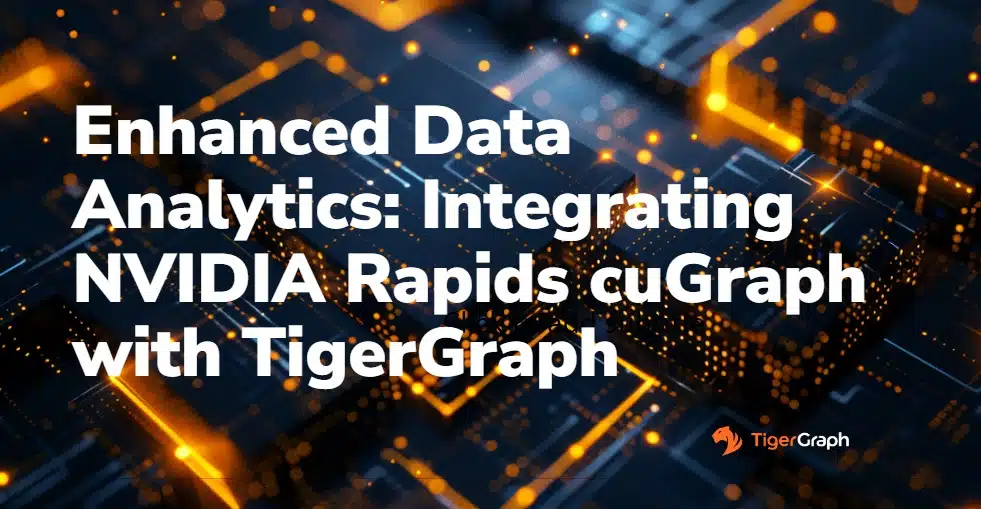In the rapidly evolving landscape of data analytics and artificial intelligence (AI), the recent talk by Dan McCreary, Head of AI at TigerGraph, at the NVIDIA GTC event stands out as a significant milestone. His presentation, titled “Enhanced Data Analytics: Integrating NVIDIA Rapids cuGraph with TigerGraph,” shed light on the critical importance of graph databases in AI and the groundbreaking work TigerGraph is doing in collaboration with NVIDIA. This blog dives into the key insights from Dan’s talk and the implications for the future of AI and data analytics.
The Critical Role of Graph Databases in AI
Dan McCreary kicked off his presentation by emphasizing the crucial role of graph databases in the realm of AI. Graph databases, unlike their relational and non-relational counterparts, are designed to handle highly interconnected data efficiently. This characteristic makes them particularly suited for applications that require the analysis of complex relationships between data points, such as fraud detection in banking—a field where TigerGraph has already marked its prowess with several successful implementations.
Drawing inspiration from Jeff Hawkins’ theories on the brain, as outlined in his books, Dan used a poignant quote to set the stage: “The key to artificial intelligence has always been the representation.” This statement highlights a fundamental challenge in AI: accurately modeling and representing the data in a way that machines can effectively process and learn from.
Navigating the Representation Problem in AI
Dan’s talk delved into the representation problem in AI, a crucial hurdle to achieving more advanced and efficient AI systems. He identified four key types of data representations used in AI today: images, sequences, tables, and graphs. Each of these representations has its domain of applicability and associated challenges, but Dan’s focus was on graph representations due to their ability to model complex relationships and dynamics.
One of the main challenges with graph data is its inherent sparsity and the difficulty of optimizing these representations for hardware. This is where the collaboration between TigerGraph and NVIDIA becomes pivotal. Dan walked the audience through the complexities of dense and sparse matrix representations and discussed the journey towards achieving a fully hardware-optimized graph system.
Leveraging NVIDIA’s RAPIDS cuGraph for Breakthroughs in Performance
The partnership between TigerGraph and NVIDIA has been instrumental in addressing the challenges of graph data analytics. Dan highlighted how TigerGraph is leveraging NVIDIA’s RAPIDS cuGraph libraries to tackle the problems associated with sparse matrix representations. The discussion touched upon the pros and cons of using Python for these tasks but underscored the substantial performance improvements enabled by NVIDIA’s RAPIDS libraries.
A highlight of Dan’s presentation was the demonstration of up to 100x speedups in performance when utilizing NVIDIA GPUs for algorithms like PageRank. This impressive achievement underscores the potential of graph analytics when combined with powerful hardware acceleration, offering a glimpse into the future of AI where graph representations play a central role.
The Synergy Between TigerGraph and NVIDIA: Pioneering the Future of AI Hardware
In closing, Dan McCreary expressed his gratitude towards NVIDIA for their partnership. This collaboration is not just about achieving short-term gains in performance but about jointly paving the way for the next generation of graph-optimized hardware. By combining TigerGraph’s expertise in graph database technology with NVIDIA’s leadership in GPU technology, the two companies are at the forefront of creating solutions that can handle the complexity and scale of tomorrow’s AI challenges.
The significance of Dan McCreary’s talk at NVIDIA GTC extends beyond the technical details of integrating cuGraph with TigerGraph. It represents a pivotal moment in the evolution of AI and data analytics, highlighting the shift towards graph representations as a key enabler of more sophisticated and effective AI systems. As companies increasingly migrate to graph representations to enhance their predictive capabilities, the work being done by TigerGraph and NVIDIA will undoubtedly play a crucial role in shaping the future of AI.
In an era where the ability to analyze and leverage complex relationships in data can provide a competitive edge, the advancements discussed in Dan’s presentation offer exciting possibilities. Whether in detecting banking fraud more accurately or in understanding customer behaviors and product dynamics, the integration of NVIDIA Rapids cuGraph with TigerGraph is setting new benchmarks for what is possible in AI and data analytics.
The journey towards a future where AI can more closely mimic the intricacies of human intelligence and decision-making is fraught with challenges. Yet, with visionaries like Dan McCreary leading the charge and fostering collaborations between industry giants like TigerGraph and NVIDIA, the path forward seems not only clearer but also significantly more promising. As we look ahead, the continued innovation in graph database technology and hardware optimization heralds a new era for AI—one that is more intelligent, efficient, and capable of understanding the complex web of relationships that define our world.

